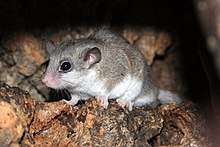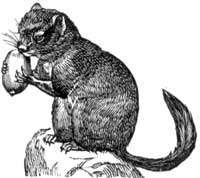Dormouse
A dormouse is a rodent of the family Gliridae (this family is also variously called Myoxidae or Muscardinidae by different taxonomists). Dormice are nocturnal animals found in Africa, Asia, and Europe, and are particularly known for their long periods of hibernation.[2]
| Dormice | |
|---|---|
 | |
| African dormouse, Graphiurus sp. | |
| Scientific classification | |
| Kingdom: | Animalia |
| Phylum: | Chordata |
| Class: | Mammalia |
| Order: | Rodentia |
| Suborder: | Sciuromorpha |
| Family: | Gliridae Muirhead in Brewster, 1819[1] |
| Subfamilies and genera | |
As only one species of dormouse – the hazel dormouse – is native to the United Kingdom, in everyday English usage "dormouse" can refer either to that one species or to the family as a whole.
The English name of the species derived from the French dormeuse, and the latter in turn possibly from the Languedocien radourmeire.[3]
Etymology
Concerning the dormouse's name, etymonline says "long-tailed Old World rodent noted for its state of semi-hibernation in winter, early 15c., possibly from Anglo-French dormouse 'tending to be dormant' (from stem of dormir 'to sleep,' see dormant), with the second element mistaken for mouse; or perhaps it is from a Middle English dialectal compound of mouse (n.) and Middle French dormir. French dormeuse, fem. of dormeur 'sleeper' is attested only from 17c."[4]
Characteristics
Dormice are small rodents, with body lengths between 6 and 19 cm (2.4 and 7.5 in), and weights between 15 and 180 g (0.53 and 6.35 oz). They are generally mouse-like in appearance, but with furred, rather than scaly, tails. They are largely arboreal, agile, and well adapted to climbing. Most species are nocturnal. Dormice have an excellent sense of hearing and signal each other with a variety of vocalisations.[5]
Dormice are omnivorous, and typically feed on berries, flowers, fruits, insects, and nuts. They are unique among rodents in that they lack a cecum, a part of the gut used in other species to ferment vegetable matter. Their dental formula is similar to that of squirrels, although they often lack premolars:
| Dentition |
|---|
| 1.0.0–1.3 |
| 1.0.0–1.3 |
Dormice breed once or occasionally twice each year, producing litters with an average of four young after a gestation period of 22–24 days. They can live for as long as five years. The young are born hairless and helpless, and their eyes do not open until about 18 days after birth. They typically become sexually mature after the end of their first hibernation. Dormice live in small family groups, with home ranges that vary widely between species and depend on the availability of food.[5]
Hibernation
One of the most notable characteristics of those dormice that live in temperate zones is hibernation. They can hibernate six months out of the year, or even longer if the weather does not become warm enough, sometimes waking for brief periods to eat food they had previously stored nearby. During the summer, they accumulate fat in their bodies to nourish them through the hibernation period.[5]
The sleepy behaviour of The Dormouse character in Lewis Carroll's Alice's Adventures in Wonderland reflects this familiar trait of dormice.
Relationship with humans
The edible dormouse (Glis glis) was considered a delicacy in ancient Rome, either as a savoury appetizer or as a dessert (dipped in honey and poppy seeds). The Romans used a special kind of enclosure, a glirarium, to raise and fatten dormice for the table.[5] It is still considered a delicacy in Slovenia and in several places in Croatia, namely Lika, and the islands of Hvar and Brač.[6][7] Dormouse fat was believed by the Elizabethans to induce sleep since the animal put on fat before hibernating.[8]
In more recent years[9] dormice have begun to enter the pet trade, though they are uncommon as pets and are considered an exotic pet. The woodland dormouse (Graphiurus murinus) is the most commonly seen species in the pet trade.[10] Asian garden dormice (Eliomys melanurus) are also occasionally kept as pets.[11]
Evolution
The Gliridae are one of the oldest extant rodent families, with a fossil record dating back to the early Eocene. As currently understood, they descended in Europe from early Paleogene ischyromyids such as Microparamys (Sparnacomys) chandoni. The early and middle Eocene genus Eogliravus represents the earliest and most primitive glirid taxon; the oldest species, Eogliravus wildi, is known from isolated teeth from the early Eocene of France and a complete specimen of the early middle Eocene of the Messel pit in Germany.[12] They appear in Africa in the upper Miocene and only relatively recently in Asia. Many types of extinct dormouse species have been identified. During the Pleistocene, giant dormice the size of large rats, such as Leithia melitensis, lived on the islands of Malta and Sicily.[13]
Classification
The family consists of 29 living species, in three subfamilies and (arguably) nine genera:
Family Gliridae – Dormice
- Subfamily Glirinae
- Genus Glirulus
- Japanese dormouse, Glirulus japonicus
- Genus Glis
- Edible dormouse, Glis glis
- Genus Glirulus
- Subfamily Graphiurinae
- Genus Graphiurus, African dormice
- Angolan African dormouse, Graphiurus angolensis
- Christy's dormouse, Graphiurus christyi
- Graphiurus walterverheyeni [14]
- Jentink's dormouse, Graphiurus crassicaudatus
- Johnston's African dormouse, Graphiurus johnstoni
- Kellen's dormouse, Graphiurus kelleni
- Lorrain dormouse, Graphiurus lorraineus
- Monard's dormouse, Graphiurus monardi
- Nagtglas's African dormouse, Graphiurus nagtglasii
- Rock dormouse, Graphiurus platyops
- Silent dormouse, Graphiurus surdus
- Small-eared dormouse, Graphiurus microtis
- Spectacled dormouse, Graphiurus ocularis
- Stone dormouse, Graphiurus rupicola
- Woodland dormouse, Graphiurus murinus
- Genus Graphiurus, African dormice
- Subfamily Leithiinae
- Genus Chaetocauda
- Chinese dormouse, Chaetocauda sichuanensis
- Genus Dryomys
- Balochistan forest dormouse, Dryomys niethammeri
- Forest dormouse, Dryomys nitedula
- Woolly dormouse, Dryomys laniger
- Genus Eliomys, garden dormice
- Asian garden dormouse, Eliomys melanurus
- Garden dormouse, Eliomys quercinus

- Maghreb garden dormouse, Eliomys munbyanus
- Genus Hypnomys† (Balearic dormouse)
- Majorcan giant dormouse, Hypnomys morphaeus†
- Minorcan giant dormouse, Hypnomys mahonensis†
- Genus Leithia†
- Leithia cartei†
- Maltese giant dormouse, Leithia melitensis†
- Genus Muscardinus
- Hazel dormouse, Muscardinus avellanarius
- Genus Myomimus, mouse-tailed dormice
- Masked mouse-tailed dormouse, Myomimus personatus
- Roach's mouse-tailed dormouse, Myomimus roachi
- Setzer's mouse-tailed dormouse, Myomimus setzeri
- Genus Selevinia
- Desert dormouse, Selevinia betpakdalaensis
- Genus Chaetocauda
Fossil species
- Subfamily Bransatoglirinae
- Genus Bransatoglis
- Bransatoglis adroveri Majorca, Early Oligocene
- Bransatoglis planus Eurasia, Early Oligocene
- Genus Oligodyromys
- Genus Bransatoglis
References
- Davis Brewster, ed. Edinburgh Encyclopædia, 1819.
- "Species – Dormouse". The Mammal Society. Retrieved March 8, 2018.
- Wedgwood, Hensleigh (1855). "On False Etymologies". Transactions of the Philological Society (6): 66.
- "dormouse (n.)". etymonline.com. Retrieved March 24, 2019.
- Baudoin, Claude (1984). Macdonald, D. (ed.). The Encyclopedia of Mammals. New York: Facts on File. pp. 678–680. ISBN 978-0-87196-871-5.
- Freedman, Paul (March 6, 2008). "Meals that Time Forgot". Gourmet.com. Archived from the original on March 11, 2008. Retrieved February 13, 2017.
- Kolumbić, Igor. "Fifth Puhijada". otok-hvar.com. Hvar: Offero Prima d.o.o. Retrieved February 13, 2017.
- "10 ways to get a really good sleep". BBC. 27 March 2009. Retrieved February 13, 2017.
- "www.oocities.org/efexotics/africandormouse.html". 2009.
As far as I know, my own pet shop in Cambridgeshire was the first pet shop in Britain to regularly stock the species (this was as recently as the 1990s).
- "Dormice".
- "Asian Garden Dormice".
- Storch, G.; Seiffert, C. (2007). "Extraordinarily preserved specimen of the oldest known glirid from the middle Eocene of Messel (Rodentia)". Journal of Vertebrate Paleontology. 27 (1): 189–194. doi:10.1671/0272-4634(2007)27[189:EPSOTO]2.0.CO;2.
- Savage, RJG; Long, MR (1986). Mammal Evolution: an illustrated guide. New York: Facts on File. p. 119. ISBN 978-0-8160-1194-0.
- Holden, Mary Ellen; Levine, Rebecca S (2009). "Chapter 9. Systematic Revision of Sub-Saharan African Dormice (Rodentia: Gliridae: Graphiurus) Part II: Description of a New Species of Graphiurus from the Central Congo Basin, Including Morphological and Ecological Niche Comparisons with G. crassicaudatus and G. lorraineus". Bulletin of the American Museum of Natural History. 331: 314–355. doi:10.1206/582-9.1.
Further reading
- Holden, M. E. & Wilson, D. E. (Editor) & Reeder, D. M. (Editor) (2005). "Family Gliridae". Mammal Species of the World a Taxonomic and Geographic Reference. Baltimore: Johns Hopkins University Press. pp. 819–841.CS1 maint: uses authors parameter (link)
External links
| Wikimedia Commons has media related to Gliridae. |
- "Dormice". The PiedPiper.
- "Dormouse". BBC Wales Nature.
- Glirarium.org (in English and German)